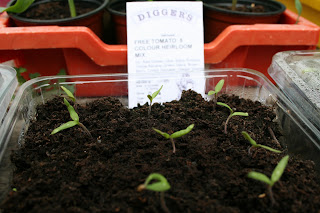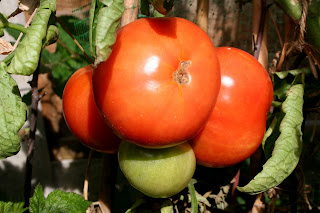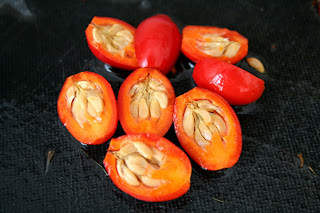Tomato growing was one of my most exciting projects this summer. Having tried planting tomato seeds many times in the tropics as a child and watching the seedlings flop over at about 3 inches high, I had never attempted growing this fruit again until now.
Early this year, whilst unpacking some boxes, I found a packet of unopened heritage tomato seeds from Diggers Club Australia. It had been in a box for three years but I thought I would stick some in compost to see if they would germinate.
 |
I tucked some amongst the calendulas as I've read that these plants would help to repel pests. Others were grown next to the sweetcorn further down the garden and one was planted in a pot.
It was exciting, watching and waiting, not knowing what variety each plant was going to be until later in the season.
In the end, one tomato plant grew into a bush variety called 'Brown Berry'. The fruits were juicy and very sweet. I'd definitely grow more of these next year.
Another plant turned out to be a vigorous growing Grosse Lisse with big potato leaves. The fruits grew so large and heavy that the entire plant, even with stakes, eventually collapsed onto the calendulas and pea plants behind it. Stronger stakes next year!
The rest were mid-sized plants which I 'stopped' at 2-3 feet high. The fruits were elongated with light green streaks but as they ripened, the lot turned to a lovely yellow colour. It was quite a mystery at first why one yellow fruit would taste so different from another yellow fruit. After some 'Googling' the penny dropped: they are two different varieties, Cream Sausage and Banana Legs!
   |
| Banana Legs ripening in late summer |
   |
| Pot grown Banana Legs in early autumn |

The last tomatoes were picked today and none had suffered from blight. Was it beginner's luck, companion planting with calendulas or wind direction?
 |
| Grosse Lisse, Banana Legs and Cream Sausage tomatoes |
 |
| Brown Berry and Banana Legs tomatoes |































